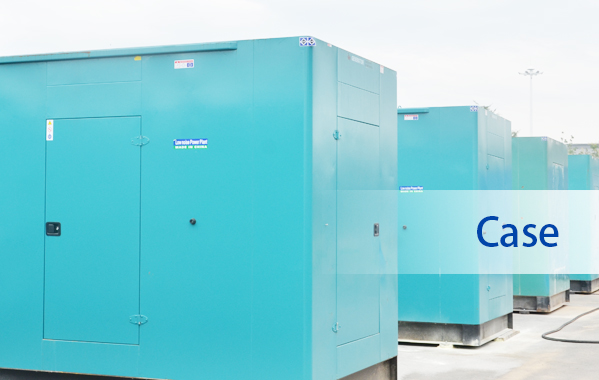Standby service cable
The Electricity Supply Authority can be asked to bring two separate service cables into the building. They will normally make a charge for this. But it provides security against a fault in one of the cables. It does not, of course, give security against a failure of the public supply altogether.
In heavily built up areas, such as London and other large cities, the public distribution system is in the form of a network and each distribution cable in the streets is fed from a sub-station at each end. The supply system itself thus contains its own standby provision. The only addition the building developer can make is to duplicate the short length of cable from the distributor in the road into the building, and it may be doubted whether the risk of this cable failing is sufficiently great to justify the cost of duplicating it. In rural areas the service cable to individual buildings may be quite long, and may take the form of an overhead line rather than an underground cable. The risk of damage is thus greater than in urban areas and there is much more reason for installing a duplicate cable.
Battery systems
A central battery system can also provide D.C. power. The next possibility is for the battery to feed a thruster inverter which then gives A.C. power. It is difficult to install and keep charged a battery large enough to give the quantities of power needed in a whole building. In building services, in practice batteries are used for emergency lighting but seldom for emergency power.
A battery system will give an emergency supply only for as long as the battery charge lasts. It then becomes dependent on a restoration of the mains supply for long enough to recharge the battery. Thus we can see that this system does not protect against long interruptions of the public supply.
Standby generators
A diesel or gas turbine generator set can be installed in a building to provide electricity when the public supply fails. This is a complete form of protection against all possible interruptions of the main supply. The generator can be large enough to supply all the needs of building and its output can be connected to the ordinary mains immediately after the Supply Authority's meters and it then provides standby facilities for the entire building. It is cheaper, and may be adequate for the risk to be guarded against, to have a smaller generator serving only the more important outlets. In this case, the distribution must be arranged so that these outlets can be switched from main to emergency supply at one point and so that there is no unintentional path from the emergency generator to outlets not meant to be served by it. In effect the building is divided at the main intake into two distribution systems and only one of them is connected to the emergency change over switch. It is also possible to install a completely separate system of wiring from the emergency generator to outlets quite distinct from the normal ones. This may be the simplest thing to do in a small building or when the emergency supply is required to serve only one or two outlets. It has the disadvantage that individual pieces of equipment have to be disconnected from one outlet and reconnected to another. Whilst this may not be acceptable in a hospital it may be quite in order in a large residence or hostel to have one or two emergency power points into which vacuum cleaners and other domestic equipment can be plugged when the main power supply is interrupted.
Buildings in which standby generators have been installed include poultry farms, Chemical process plants, hospitals, telephone exchanges, computer rooms and prisons.
An emergency generator can be started either manually or automatically. A manual start is simple, but it involves a delay during which the building is without power. This delay can be avoided by automatic starting, initiated by a sensing unit which detects a drop in the mains voltage.
It takes 8 to 10s for a diesel generator to come to full speed. With the system just described this period is needed to bring the emergency supply into action after the mains have failed and, therefore, during this period there is no supply to the load. In some applications an interruption even if this short duration is not acceptable, and a more complex arrangement is necessary. In one system the diesel engine is coupled to a clutch the other side of which is connected to a squirrel cage induction motor. The induction motor drives an alternator through a flywheel, and the alternator supplies the load. Under normal conditions the induction motor is connected to the mains and the set operates as a motor alternator supplied from the mains. When the mains fail the motor is disconnected from the mains and the diesel engine is started. As soon as it reached its running speed, the clutch operates and the alternator is driven through the shaft of the motor by the diesel engine. During the time it takes for the engine to come up to speed the alternator is kept going by the flywheel. The automatic controls required for this arrangement are similar to those already described.
Clearly this scheme is much more expensive and involves some permanent losses in the motor alternator set. It is used only for comparatively small power outputs for special purposes, such as telecommunications and power for aircraft landing systems.
Standby generators are normally supplied as complete units on a stand. The diesel engine is a normal engine with a governor, and it would be outside the scope of this book to enter on a description of diesel engines. The alternator is directly coupled to the engine and has an automatic voltage regulator. The commonest type of alternator used is the screen protested brushless machine. It is directly coupled to the engine and in smaller sizes may be overhung. In larger sizes it is supported at both ends from the set base plate. A separate exciter is mounted within the casing on the main shaft. In most modem sets the automatic voltage regulator is one of the static types. Finally, there is a control panel with voltmeters, ammeters, battery charger, incoming and outgoing terminals and the relays and circuits for the automatic start and stop control. A fuel tank is needed for the diesel engine, but this is normally supplied as a separate item and fixed independently of the generator set, with a short fuel pipe between them.
Diesel engines are noisy and it is prudent to arrange some form of sound-attenuating enclosure. The enclosure must have openings for fresh air to the engine and for the engine exhaust, and these openings will be found to limit the degree of silencing that can be achieved. Several manufacturers supply diesel generator sets complete in an enclosure which provides silencing and is also weatherproof, so that the set can be installed outdoors.
Similar generating sets can, of course, be used to supply power to a building under normal conditions. In the United Kingdom it is not economic for a consumer to generate his own power. But there are still parts of the world where it is a reasonable proposition.
There are, however, cases in industrial countries where it is economic for a consumer to use his own generating plant to supply a peak load. Many factories are supplied on a tariff which includes a charge for the peak instantaneous load. A factory may have a process which takes a fairly steady load during most of the day with a high peak for one or two hours. It may then be economic to limit the power taken from the public supply to rather less than the maximum needed and to make up the deficiency at peak times with the factory's own plant. The public mains are used at all times and are used by themselves so long as the load is less than 300kVA. As soon as the load exceeds this figure the factory's own generating plant is started and is run in parallel with the public mains. The power taken from the public mains is limited to a maximum of 300kVA at all times.
The same type of diesel generator is used for this application as for standby purposes. The start up and shut down sequences are initiated automatically by a kVA meter instead of by a voltage detector, but are otherwise similar to those already described.








